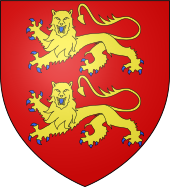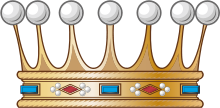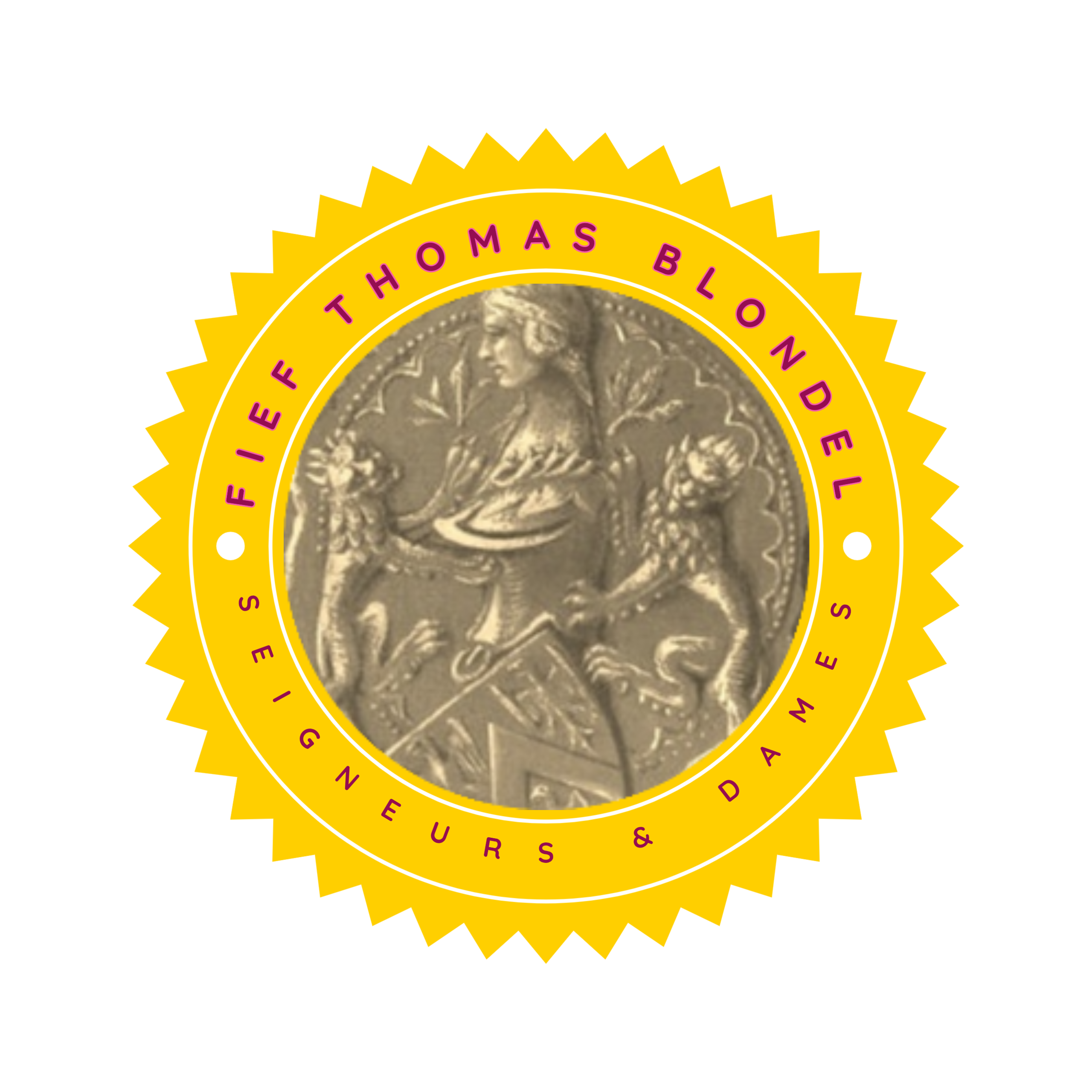


TITLES OF GUERNESEY - Fief Blondel Est. 1179-1248 ADIn 1020 AD, Duke Richard II divides Guernsey diagonally from two halves, granting south-east to Néel, Viscount Cotentin and west to Anchetel, Vicomte du Bessin. The Clos du Valle was apparently wasteland. The two initial fiefs had some vicissitudes, but at the time of the conquest of England both returned to the families of the original holders. Evolution of the Fief of Cotentin: After the Battle of Val Dunes (1047), Duke William II created and granted several ecclesiastical fiefs. From 1144 to 1150 the whole island belonged to Geoffrey d'Anjou. The wasteland of the Fief du Cotentin as part of the possessions of Geoffrey became under his son Fief Le Roi. New sub-fiefs arose during the 11th and 12th centuries as Fief Aux Fay and Fief Burons. The Fief Au Fay took place by paying a pair of silver spurs and the Burons Fief by paying a pair of golden ears. Both were combined as the Fief of Spurs with the obligation to pay a pair of spurs vermeil while the other Fief L'Eperons remained independent with Fief Blondel. After 1204 the Crown obtains certain territories holders of Norman form previous that decided to pay homage to France, thus losing their island territories. It is at the origin of some fiefs as the stronghold of Bruniaux, Fief Au Marchantet Fief Hailla. Stronghold of Sausmarez originated in the Barneville stronghold. From St. Martin s and related to the defense of the church originates Fief de la Velleresse (velleresse to ensure = keep a watch on the coast, having this obligation) Fief le King/Roi were originally from Fief de Rozel formerly owned by the Cotentin family of Rosel, who passed
to the Crown in 1204 with the fief granted by Duke William II to the The evolution of the lands in the parish of Torteval is complicated, because although initially in the Fief of the Cotentin, many of its fiefs cover St. Pierre-du-Bois, which is part of the Fief du Bessin. The original Fief Au Cannely (granted to the Cherbourg family and, of course, in the territory of the Fief du Cotentin) has been replaced by several sub-fiefs of marriages and settlements: Fief Guillot Justice, Fief Janin Besnard, Private Fief of Thomas Blondel , Fief Bouvée Duquemin, Fief Robert de Va (or Worm), Fief Jean du Gaillard (who passes to the Crown in the early sixteenth century), etc. .. A perplexing overlap of territories thus emerges. Since 1248, the number and boundaries of fiefs was much as at present. Evolution of the Fief of Bessin: The Fief du Bessin consisting of the Vintaine de L'Epine and the parishes of Castel, Saint-Sauveur and Saint Pierre-du-Bois, became Fief Le Comte in 1120 when Ranulf the "Vicomte du Bessin" was created Count of Chester. 12th century, the fief was divided into sub-fiefs: Fiez Rozel, Fief Longues, Fief Suart and Fief Sotuas.Fief San Michel was from a donation of fallow uncultivable monastery of the name After 1204 the stronghold that Suart divided into two parts, one to the Crown while the rest was named fief Reveaux.Four half of the Suart Fief retained by the Crown while the other half given to the Revel family led to the emergence of the Fief de Gohiers, stronghold of Pomare and others. Agricultural Developments and Sales in the Fief The Account originates from new sub-fiefs such as Fief Groignet, Fief Carteret, Fief Grantez or Fief Videclin. In the same way, the cession of lands of St. Michel represented the Fief Saumarez and the Fief Jean du Galliard. The number of Guernsey fiefs has remained unchanged since the 14th century. The titles were kept in some cases, the same families ans (Sausamez). All 75 Lordships are perfectly documented; This is not the case with the other titles of the Channel Islands. In January 2004, 24 Private Lords or "Free Lords" held a total of 46 Lordships which included lands or feudal rights to the land which means that some Lords stall more than one title. Two more Seigneures (Riviere and Beuval) are held by more than one person and the fiefs of 27 others belong to the Crown. The title is transferred by means of conveyance or transport in Guernsey Records and Her Majesty's Records. The transfer must be consistent with Guernsey's ancient practices. This means that the will or the means of transport must be made in accordance with the Guernsey Law. The document is registered in the HM Registry
THE FEODAL SYSTEM As in England and according to a centuries-old system, fiefs can be sold by lords to other individuals. Each lord is bound, according to custom, to make faith and homage to the duke or his representative. This tribute is sometimes staged during Queen's state visits to the Channel Islands. Unlike the Lord of Sark, the lords of Ceuresi have retained only the feudal rights, but have lost all their rights seigneuriaux since the nineteenth century and in the following. The lords played a social role until the first half of the 20th century. The feudal courts have also practically disappeared, with the exception of the courts of the feud Le Comte (family Lenfestey) or the fief of Blanchelande (the bailiff of Guernsey, ex officio , Saint-Martin). The seneschal of a fief, and his officers were usually chosen from the inhabitants of the fief, as required by feudal custom. In the example of the stronghold of Blanchelande, which formerly belonged to a priory of the former abbey of Blanchelande (in Neufmesnil, France, Manche), the court of fief is still composed today of the seneschal, four vavasseurs, and officers are the clerk and his clerk, the provost, a sergeant and a grenetier . In the fiefs, this court was held either in a special room or plaids room, or on a stone bench located on a main axis of the lordship. Some of these benches have been preserved. The 1980 Feudal Laws Act permanently extinguished the private character of the remaining seigneurial royalties by transferring them to the Crown. In 2002, a complementary law provided for the abolition in 2003 of the "thirteenth" right (transfer tax) for the benefit of private lords, because of the exemption enjoyed by the farms held in strongholds and the fiefs (seigneuries) . This tax is now returned to the Crown . The lords and ladies of the most important fiefs Guernesiais traditionally sit in the Court of Chief pleas , with the lawyers practicing on the island and the constables elected parishes, during his solemn sessions "in body" (or full court ) three times per year. To sit, the lords and ladies must have paid tribute to their fief to the Crown or his representative, the Lieutenant Governor of Guernsey. However, even if the presence of lords and ladies is mandatory at these three sessions, they no longer participate in the debate but answer only to their name. This survival however indicates that the seigneuries guernesiaises preserved their moral and legal personalities . Having become owners of several seigneuries (English: baronnies or manors ), a number of stately homes have been converted into a luxury hotel (La Barbarie hotel, for the Blanchelande stronghold, or the Longueville manor, in Saint-Sauveur), or simply sold, which allows customary law. Some lords have maintained the area rich in rare botanicals, and open to visit, like the manor of Sausmarez ( Sausmarez Manor ) . It still belongs to the family Sausmarez, one of the oldest on the island with that of De Carteret.
Lord Kinnear, in Smith v. Lerwick Harbour Trustees said about the Crown's property rights: "If the solum of Shetland as a whole is not originally the property of the Crown, I know of no authority, and can see no reason, for holding (saying) that part of it which is called the foreshore is Crown Property". This statement could equally well be applied to the seabed, especially since the foreshore is regarded as part of the seabed in English law. S.O.U.L. (udallaw.com)
| ||||
Seigneur de la Fief of Blondel Lord Baron Mentz of Fief Blondel Geurnsey Crown Dependency Seigneur Fief of Blondel George Mentz Lord Baron of Fiefdom Blondel Freiherr of Fief Thomas Blondel Feudal Lord of Baronnie - Noble Fief Barony Friherre > The Island Lords Seigneur de la Fief of Blondel Lord Baron Mentz of Fief Blondel Geurnsey Crown Dependency Seigneur Fief of Blondel George Mentz Lord Baron of Fiefdom Blondel Freiherr of Fief Thomas Blondel Feudal Lord of Baronnie - Noble Fief C Seigneurs and Dames Travel Research Lord Paramount Feudal Barons The Seigneur Order Patron George Mentz Charter of Liberties Deed & Title Fief Blondel Islands Viking Kingdom Fief Worship Fiefs of the Islands ECS Extended Continental Shelf Styles and Dignities Territorial Waters Blondel Privy Seal Fief Bouvees of Fief Thomas Blondel Guernsey Court of Chief Pleas Fief Court Arms Motto Flower Fief de l'Eperon La Genouinne Kingdom of West Francia Fief DuQuemin Bouvée Phlipot Pain Bouvée Torquetil Bouvée Bourgeon Bailiwick of Ennerdale Channel Island History Fief Direct from the Crown A Funny Think Happened On the Way to the Fief Guernsey Bailiwick of Guernsey - Crown Dependency Confederation des Iles Anglo-Normandes Sovereignty Papal Bull Research Links Norse Normandy Order of the Genet Order of the Genet Order of the Star Est. 1022 Knights of theThistle of Bourbon Count of Anjou Fief Rights Blondel and King Richard Press Carnival Manorial Incidents Appointments of Seigneurs Store Portelet Beach Roquaine Bay Neustrasia Columbier Dovecote Fief Blondel Merchandise Fief Blondel Beaches Islands Foreshore Events Fiefs For Sale Sold Lords of Normandy Fief Coin Viscounts de Contentin Fief Blondel Map Feudal Guernsey Titles Board of Trustees The Feudal System Hereditaments Chancellor Flag & Arms Fief Videos Guernsey Castle Sark Contact Advowson Site Map Disclaimer Freiherr Livres de perchage Lord Baron Longford Income Tax Guernsey Valliscaulian Order Saint Benedict of the Celestines Society of Divine Compassion Dictionary Count of Mortain Seigneur de Saint-Sauveur Seigneur of Fief Ansquetil Top Success Books Datuk Seri George Mentz Order St. Benedict OSB Celestines Order of the Iron Crown Order of the White Falcon Colonel Mentz Order Red Eagle Order St. Louis Order Holy Ghost Order of Saint Anthony Order of the Black Swan Order of St Columban Order of the Iron Helmet Livonian Brothers of the Sword Fief treizième and Direct from Crown Valuation Fief Blondel Prince of Annaly Teffia
Feudal Lord of the Fief Blondel of the Nordic Channel Islands Guernsey Est.
1179
Feudalherr - Fief Blondel von der Nordischen Insel Guernsey Est. 1179
New York Gazette - Magazine of Wall Street -
George Mentz -
George Mentz - Aspen Commission - Mentz Arms
Counselor George Mentz Esq. - Seigneur Feif BlondelBaron Annaly Baron Moyashel Grants to Delvin About Longford Styles and Dignities The Seigneur Court Barons Fiefs of the Islands Longford Map The Island Lords Market & Fair Fief Worship Channel Island History Fief Blondel Lord Baron Longford Fief Rights Fief Blondel Merchandise Events Blondel and King Richard Fief Coin Feudal Guernsey Titles The Feudal System Flag & Arms Castle Site Map Disclaimer Blondel Myth DictionaryMentz Scholarship Program 101 Million Donation - Order of the Genet Knighthood |





George Mentz Education -
Commissioner George Mentz
-
https://finance.yahoo.com/news/commissioner-george-mentz-clinches-influencer-180000705.html
-
George Mentz News -
George Mentz Net Worth - George Mentz Noble Tilte -
George Mentz -
George Mentz Trump Commissioner -
George Mentz Freiherren Count Baron -
George Mentz Global Economic Forum -
George Mentz Donates Millions
 Abbey of Marmoutiers. Geoffrey d'Anjou created in 1150 when he was developing his plans for the
invasion of two military fiefs De Vaugrat of England and Bruniaux in the parish of St. Sampson. Fief Anneville
granted by Henry III to Sir William de Cheny in 1248 is also from this parish.
Abbey of Marmoutiers. Geoffrey d'Anjou created in 1150 when he was developing his plans for the
invasion of two military fiefs De Vaugrat of England and Bruniaux in the parish of St. Sampson. Fief Anneville
granted by Henry III to Sir William de Cheny in 1248 is also from this parish.